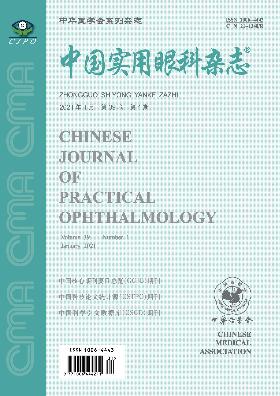Application of vivo confocal microscopy after Corneal collagen cross link in Keratoconus
引用次数: 0
Abstract
Objective To study the characteristics of vivo confocal microscopy after corneal collagen cross link, and to evaluate the efficacy of corneal collagen cross-linking for keratoconus therapy. Methods A total of 23 keratoconus patients (23 eyes) with corneal thickness no less than 400 μm were recruited in this study. Corneal epithelium of central 9 mm was removed mechanically under topical anesthesia, 0.1% riboflavin was applied. Then standard UVA/riboflavin corneal crosslinking was applied. VA, Slit lamp, anterior segment optical coherence tomography (AS-OCT), vivo confocal microscopy was examined and recorded. Results Imaging characteristics in AS-OCT: Preoperative corneal stroma was relatively uniform yellowish green and reflective, postoperative anterior corneal storma emerges relatively dense yellow and green high reflectance, posterior stroma was relatively loose green-based low reflection. Imaging characteristics in vivo confocal microscopy: Preoperative corneal stroma fibers wrinkles showed low reflective stripes, postoperative corneal storma showed high reflective stripes along the dark stripes, and it was more obvious in the anterior storm than the posterior stroma. Conclusions Vivo confocal microscopy shows clear morphological evidence in CXL. UVA/0.1% riboflavin corneal crosslinking achieve conductive riboflavin penetration, and it is safe and effective in the treatment of keratoconus. Key words: Vivo confocal microscopy; UVA/riboflavin corneal crosslinking; Riboflavin; Corneal thickness; Keratoconus角膜胶原交联后体内共聚焦显微镜在圆锥角膜中的应用
目的研究角膜胶原交联后体内共聚焦显微镜的特点,评价角膜胶原交联治疗圆锥角膜的疗效。方法选取角膜厚度不小于400 μm的圆锥角膜患者23例(23只眼)。表面麻醉下机械切除角膜中央9 mm上皮,应用0.1%核黄素。然后应用标准UVA/核黄素角膜交联。检查并记录VA、裂隙灯、前段光学相干断层扫描(AS-OCT)、体内共聚焦显微镜。结果AS-OCT影像学特征:术前角膜基质呈相对均匀的黄绿色反射,术后角膜前基质呈相对致密的黄绿色高反射,后基质呈相对疏松的绿色低反射。活体共聚焦显微镜成像特征:术前角膜间质纤维褶皱呈低反射条纹,术后角膜风暴沿暗条纹呈高反射条纹,且风暴前较后间质明显。结论体内共聚焦显微镜显示出明显的CXL形态学证据。UVA/0.1%核黄素角膜交联可实现核黄素导电渗透,治疗圆锥角膜安全有效。关键词:体内共聚焦显微镜;UVA/核黄素角膜交联;核黄素;角膜厚度;圆锥形角膜
本文章由计算机程序翻译,如有差异,请以英文原文为准。
求助全文
约1分钟内获得全文
求助全文
来源期刊
自引率
0.00%
发文量
9101
期刊介绍:
China Practical Ophthalmology was founded in May 1983. It is supervised by the National Health Commission of the People's Republic of China, sponsored by the Chinese Medical Association and China Medical University, and publicly distributed at home and abroad. It is a national-level excellent core academic journal of comprehensive ophthalmology and a series of journals of the Chinese Medical Association.
China Practical Ophthalmology aims to guide and improve the theoretical level and actual clinical diagnosis and treatment ability of frontline ophthalmologists in my country. It is characterized by close integration with clinical practice, and timely publishes academic articles and scientific research results with high practical value to clinicians, so that readers can understand and use them, improve the theoretical level and diagnosis and treatment ability of ophthalmologists, help and support their innovative development, and is deeply welcomed and loved by ophthalmologists and readers.

 求助内容:
求助内容: 应助结果提醒方式:
应助结果提醒方式:


